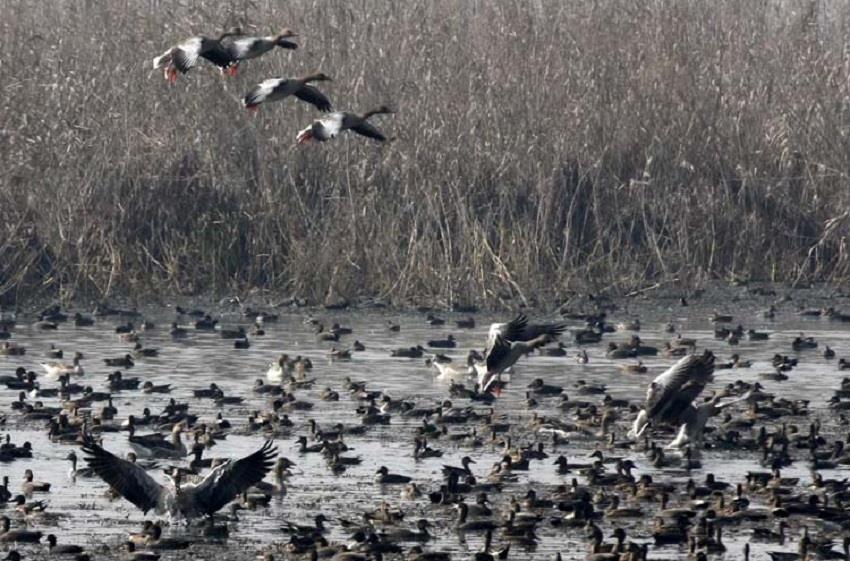
Kashmir's Migratory Birds Offer A Lesson In Survival
Kashmir's Migratory Birds Offer a Lesson in Survival
By Mohammad Hanief
Every winter, as cold seeps into the valley, the skies fill with wings. Bar-headed geese, pintails, teals, herons, and gulls arrive from the frozen stretches of Siberia, Central Asia, and northern Europe.
These avian guests turn the wetlands into living paintings of movement and sound, marking a presence older than memory, a sign of nature's strength and of the delicate balance that the valley must maintain.
ADVERTISEMENTThis year, the spectacle has been more vibrant than usual.
Early counts suggest a rise in the number of visiting birds. Wular Lake, one of Asia's largest freshwater lakes, shows a remarkable rebound, and smaller wetlands like Hokersar, Hygam, Shallabugh, and Dal Lake are also seeing renewed life.
These wetlands sustain local communities, irrigate fields, and nurture the valley's ecological web. The surge in bird numbers signals hope, proof that even small steps in conservation can yield results.
But the recovery is risky. Decades of neglect, pollution, and encroachment have left many wetlands struggling. Siltation has shallowed lakes, invasive plants choke waterways, and urban waste continues to flow into waters that once reflected the snow peaks. Conversion of marshes into farmland has robbed countless species of shelter. These scars run deep.
The increase in birds this season carries a dual message. It reflects the improvement in Kashmir habitats, but it also hints at trouble elsewhere.
Drying wetlands, urban sprawl, and changing climates along the Central Asian Flyway have forced birds to seek refuge wherever water and food remain. The valley's success is therefore a reminder and a warning: nature survives here, but may vanish elsewhere.
Kashmir holds a crucial place on the Central Asian Flyway, a migratory route spanning thousands of kilometers from the Arctic to the Indian Ocean. Its lakes and marshes serve as resting grounds for birds on perilous journeys. Their arrival signals ecological balance, water health, and global interconnectedness.
Each returning flock carries a message: life persists here. Each absence warns that something has been lost.
Focused restoration work has begun to bear fruit. Desilting, encroachment removal, and careful water management have revived stretches of wetland. Community participation has grown. Fishermen and boatmen, once sidelined, are now partners in conservation.
When locals see lakes as shared assets, the work of recovery gains permanence.
But governance remains a challenge. Conservation in Kashmir often depends on short-term projects. Each new administration brings different priorities, while wetland restoration demands long-term consistency. Jurisdictional overlaps between local bodies, forest authorities, and development agencies complicate matters.
Effective protection requires integrated management, where environmental, social, and economic interests converge.
But climate change threatens these gains. Rising temperatures, erratic rainfall, and shifting snowfall disrupt migration patterns and water levels. Wetlands may dry prematurely or flood beyond capacity.
Birds, attuned to environmental cues for breeding and feeding, face increasing stress. Recent fluctuations in arrival times reflect this uncertainty, and the ecological clockwork of the valley feels the strain.
The flocks have also sparked growing interest from birdwatchers and eco-tourists. Managed wisely, this interest can generate sustainable livelihoods. Guided lake tours and birding trails can benefit local communities if strictly regulated.
Wetlands must not become playgrounds for mass tourism. Conservation tourism thrives on respect, for the birds, the people, and the ecosystems.

Legal Disclaimer:
MENAFN provides the
information “as is” without warranty of any kind. We do not accept
any responsibility or liability for the accuracy, content, images,
videos, licenses, completeness, legality, or reliability of the information
contained in this article. If you have any complaints or copyright
issues related to this article, kindly contact the provider above.

















Comments
No comment